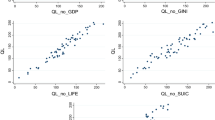Abstract
Perhaps the most difficult aspect of constructing a multi-dimensional index is that of choosing weights for the components. This problem is often bypassed by adopting the ‘agnostic’ option of equal weights, as in the human development index. This is an annual ranking of countries produced by the United Nations Development Programme based on life expectancy, education, and per capita gross national income. These three dimensions are now aggregated multiplicatively. Whatever weights (exponents) are chosen for these dimensions, some nations will feel disadvantaged. To avoid the use of arbitrary weights, we propose for consideration a two-step approach: (1) find the most advantageous set of weights for each nation in turn, and (2) regress the associated optimal scores on the underlying indicators to find a single weight set. This approach has the properties of non-subjectivity, fairness, and convenience. The result is that the highest weight is placed on the life expectancy dimension.
Similar content being viewed by others
References
Anand S, Sen A (1997) Concepts of human development and poverty: a multidimensional perspective. In: Human development papers 1997: poverty and human development. UNDP-HDRO, New York, pp 1–19
Bate R, Boateng K (2007) Drug pricing and its discontents, at home and abroad. Health Policy Outlook 9:1–9
Blancard S, Hoarau J-F (2011) Optimizing the formulation of the United Nations’ human development index: an empirical view from data envelopment analysis. Econ Bull 31(1):989–1003
Bougnol M-L, Dula JH, Estellita Lins MP, Moreira da Silva AC (2010) Enhancing standard performance practices with DEA. Omega 38:33–45
Charnes A, Cooper WW, Seiford L (1982) A multiplicative model for efficiency analysis. Socio-Econ Plann Sci 16(5):223–224
Charnes A, Cooper WW, Seiford L, Stutz J (1983) Invariant multiplicative efficiency and piecewise Cobb-Douglas envelopments. Oper Res Lett 2(3):101–103
Chatfield C, Collins AJ (1992) Introduction to multivariate analysis. Chapman & Hall, London
Chowdhury S (2005) The human development index: an exercise in objectivity. Downloadable from: http://papers.ssrn.com/sol3/papers.cfm?abstract_id=787586
Chowdhury S, Squire L (2006) Setting weights for aggregate indices: an application to the commitment to development index and human development index. J Dev Stud 42(5):761–771
Decancq K, Lugo MA (2008) Setting weights in multidimensional indices of well-being and deprivation. Oxford Poverty & Human Development Initiative, Working Paper 18
Desai M (1991) Human development: concepts and measurement. Eur Econ Rev 35(2/3):350–357
Despotis DK (2005a) A reassessment of human development index via data envelopment analysis. J Oper Res Soc 56(8):960–980
Despotis DK (2005b) Measuring human development via data envelopment analysis: the case of Asia and the Pacific. Omega 33(5):385–390
Gohou G, Soumare I (2011) Does foreign direct investment reduce poverty in Africa and are there regional differences? World development. Available online: http://www.sciencedirect.com/science/article/pii/S0305750X11001446
Grimm M, Harttgen K, Klasen S, Misselhorn M (2008) A human development index by income groups. World Dev 36(12):2527–2546
Hatefi SM, Torabi SA (2010) A common weight MCDA–DEA approach to construct composite indicators. Ecol Econ 70:114–120
Henninger N, Snel M (2002) Where are the poor? Experiences with the development and use of poverty maps. World Resources Institute, Washington, DC and UNEP/GRID-Arendal, Arendal, Norway
Herrero C, Martinez R, Villar A (2010) Multidimensional social evaluation: an application to the measurement of human development. Rev Income Wealth 56(3):483–497
Hicks DA (1997) The inequality-adjusted human development index: a constructive proposal. World Dev 25(8):1283–1298
Hoyland B, Moene K, Willumsen F (2012) The tyranny of international index rankings. J Dev Econ 97(1):1–14
Kelley AC (1991) The human development index: “handle with care”. Popul Dev Rev 17(2):315–324
Klugman J, Rodriguez F, Choi H-J (2011) The HDI 2010: new controversies, old critiques. Human Development Research Paper 2011/01. UNDP, New York
Lind N (2010) A calibrated index of human development. Soc Indic Res 98:301–319
Mahlberg B, Obersteiner M (2001) Remeasuring the HDI by data envelopment analysis. International Institute for Applied Systems Analysis (IIASA), Interim Report IR-01-069, Austria
McDonald J (2009) Using least squares and tobit in second stage DEA efficiency analyses. Eur J Oper Res 197:792–798
McGillivray M, Markova N (2010) Global inequality in well-being dimensions. J Dev Stud 46(2):371–378
Morse S (2003) For better or for worse, till the human development index do us part? Ecol Econ 45:281–296
Nguefack-Tsague G, Klasen S, Zucchini W (2011) On weighting the components of the human development index: a statistical justification. J Hum Dev Capabil 12(2):183–202
O’Neill H (2005) Ireland’s foreign aid in 2004. Ir Stud Int Aff 16:279–316
OPHI (Oxford Poverty and Human Development Initiative) (2010) Oxford University and UNDP join forces to launch a better way to measure global poverty. http://www.ophi.org.uk/news/press-releases/
Reiter SL, Steensma HK (2010) Human development and foreign direct investment in developing countries: the influence of FDI policy and corruption. World Dev 38(12):1678–1691
Sagar AD, Najam A (1998) The human development index: a critical review. Ecol Econ 25:249–264
Tofallis C (2010) Multicriteria ranking using weights which minimize the score range. In: Jones D, Tamiz M, Ries J (eds) New developments in multiple objective and goal programming. Springer, Berlin
UNDP (United Nations Development Programme) (1990) Human Development Report 1990. Oxford University Press, New York
UNDP (United Nations Development Programme) (2010) Human Development Report 2010: the real wealth of nations. UN Development Programme. Palgrave Macmillan, New York
UNDP (United Nations Development Programme) (2011) Human Development Report 2011: sustainability and equity: a better future for all. UN Development Programme. Palgrave Macmillan, New York
Zhou P, Ang BW, Zhou DQ (2010) Weighting and aggregation in composite indicator construction: a multiplicative optimization approach. Soc Indic Res 96(1):169–181
Author information
Authors and Affiliations
Corresponding author
Additional information
Responsible editor: Alessandro Cigno
Appendices
Appendix 1: Explanation of DEA using a diagram
-
1.
Explaining DEA using a two-dimensional scatter graph
For the purposes of illustration, we shall restrict attention to just two dimensions; the principles apply equally well in three dimensions. Suppose we plot the life expectancy and years of schooling for a number of countries as points on a graph as in Fig. 1.
DEA identifies the observed best practice—without having to pre-specify weights of importance. Instead, it uses a dominance argument: in the diagram below, country P is dominated by country B because the latter has a higher life expectancy and a higher level of schooling. Thus whatever weights are attached to the two criteria would cause B to have a higher score than P.
Countries A, B, and C are not dominated by any other country and so form the best-practice frontier or envelope. These are then assigned the maximum score of unity. Countries behind the frontier have their score calculated by the proportion of their distance to the frontier; thus, for P, the score would be given by the ratio OP/OP′ (where P′ is the point where the ray from the origin through P meets the frontier). So if P is three quarters of the way to the frontier, then its score would be 3/4 = 0.75.
-
2.
Going beyond DEA to obtain a single set of weights
The slope of line AB implies one set of weights—these would favour countries A and B. The slope of line BC represents another set of weights—these would favour countries B and C. The method in this paper uses regression to identify an intermediate set of weights that does not favour any one country but rather allows every country to influence the outcome whilst keeping as close as possible to the scores found in the DEA analysis.
Appendix 2: The DEA model
We solve a separate optimisation problem for each country. Let H o denote the score of the particular country being assessed. We wish to find an individual set of weights (K o, A o, B o, C o) which maximises the score for that country:
and
i.e. none of the country scores exceed 100 % using these weights.
The above problem is converted to a linear programming problem by taking the logarithms: Use K′ to denote ln(K), L′ to denote ln(L), etc. The problem then becomes
Once the optimal value is found in this way, it can be converted back using anti-logs:
Note that the optimal value of H arising from the above linear programming problem is unique, although it may be possible to achieve the same score with different weights—alternative optima. We do not use the weights in the regression stage, only the unique H values.
The scores can also be obtained using a different formulation which normalises the score of the country being assessed to unity (which means the log is zero) and then minimises the maximum score across all countries. The score of the assessed unit is then the reciprocal of the largest score:
We applied both formulations and found identical scores for all countries.
Appendix 3:
Rights and permissions
About this article
Cite this article
Tofallis, C. An automatic-democratic approach to weight setting for the new human development index. J Popul Econ 26, 1325–1345 (2013). https://doi.org/10.1007/s00148-012-0432-x
Received:
Accepted:
Published:
Issue Date:
DOI: https://doi.org/10.1007/s00148-012-0432-x





